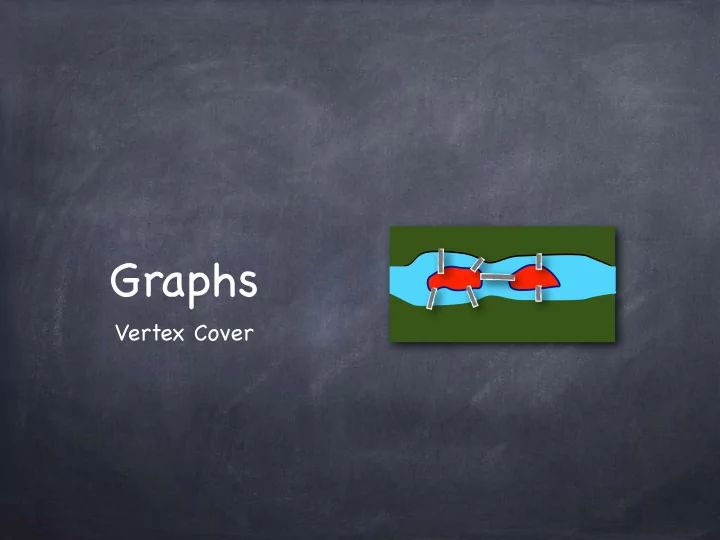

Graphs Vertex Cover
Vertex Cover A vertex cover of a graph G=(V ,E) is a set C of vertices such that every edge is covered by (incident on) at least one vertex in C i.e., C ⊆ V is a vertex cover if ∀ e ∈ E, e ∩ C ≠ Ø
Vertex Cover A vertex cover of a graph G=(V ,E) is a set C of vertices such that every edge is covered by (incident on) at least one vertex in C i.e., C ⊆ V is a vertex cover if ∀ e ∈ E, e ∩ C ≠ Ø Trivial vertex covers: V is a vertex cover. So is V-{v}, for any v ∈ V Algorithmic task: Find a small vertex cover of a given graph “Hard" (i.e., NP-hard) to find the size of smallest vertex cover Two useful results connecting the minimum vertex cover problem to the maximum matching problem (which is not a hard problem) In bipartite graphs, the size of a smallest vertex cover equals the size of a largest matching In general graphs, they are within a factor of 2 of each other
Vertex Cover and Matchings A vertex cover of a graph G=(V ,E) is a set C of vertices such that every edge is covered by (incident on) at least one vertex in C i.e., C ⊆ V is a vertex cover if ∀ e ∈ E, e ∩ C ≠ Ø A matching in a graph G=(V ,E) is a set of edges which do not share any vertex i.e., a set M ⊆ E s.t. ∀ e 1 ,e 2 ∈ M, e 1 ≠ e 2 → e 1 ∩ e 2 = Ø In any graph, ∀ vertex cover C, ∀ matching M, |C| ≥ |M| Because any vertex can cover at most one edge in M matching sizes possible matching sizes possible vertex cover sizes possible vertex cover sizes possible n n 0 0
Vertex Cover in Bipartite Graphs matching sizes possible vertex cover sizes possible n 0 K ő nig’ s Theorem: In a bipartite graph, the size of the smallest vertex cover equals the size of the largest matching Enough to prove that in a bipartite graph G=(X,Y,E), given a smallest vertex cover C, there is a matching M with |M| ≥ |C| Alternately, given a maximum matching M, show a vertex cover C with |C| ≤ |M|
Vertex Cover in Bipartite Graphs K ő nig’ s Theorem: In a bipartite graph, the size of the smallest vertex cover equals the size of the largest matching Enough to prove that in a bipartite graph G=(X,Y,E), given a smallest vertex cover C, there is a matching M with |M| ≥ |C| Let A=C ∩ X and B=C ∩ Y . Enough to show ∃ complete matchings (1) from A to Y-B and (2) from B to X-A A By Hall’ s theorem, enough to show ∄ S ⊆ A shrinking in Y-B (and similarly ∄ S ⊆ B shrinking in X-A) B Suppose S ⊆ A shrinking in Y-B. Consider C ∪ Γ (S)-S Still a vertex cover [edges covered by S are covered by Γ (S)] And strictly smaller than C! [ |C ∪ Γ (S)-S| = |C| + | Γ (S)-B| - |S| < |C|. ]
Vertex Cover in General Graphs Recall that finding (the size of) a smallest Vertex Cover is hard, but finding a maximum matching isn’ t Even easier to find a maximal matching: M is a maximal matching if no edge e ∈ E-M such that M ∪ {e} is also a matching Repeat until no more edges: pick an arbitrary edge, and delete all edges touching it If M a maximal matching, ∃ a vertex cover of size 2|M| Include both end points of each edge in M (i.e., C = ∪ e ∈ M e) M is maximal ⇒ ∄ e with both its nodes not in C ⇒ C is a vertex cover If C is a smallest vertex cover and M a maximal matching, |M| ≤ |C| ≤ 2|M|. Hence, can efficiently approximate the size of the smallest vertex cover within a factor of 2.
Vertex Cover and Independent Set In a graph G=(V ,E), I ⊆ V is said to be an independent set if there are no edges in the subgraph induced by I i.e., ∀ e ∈ E, e ⊈ I I is an independent set iff is a vertex cover I e ⊈ I ⟷ e ∩ ≠ Ø I I i.s. ⇔ ∀ e ∈ E e ⊈ I ⇔ ∀ e ∈ E e ∩ ≠ Ø ⇔ v.c. I I Hence size of smallest v.c. = n - size of largest i.s. matching sizes possible vertex cover sizes possible n 0 independent set sizes possible
Recommend
More recommend